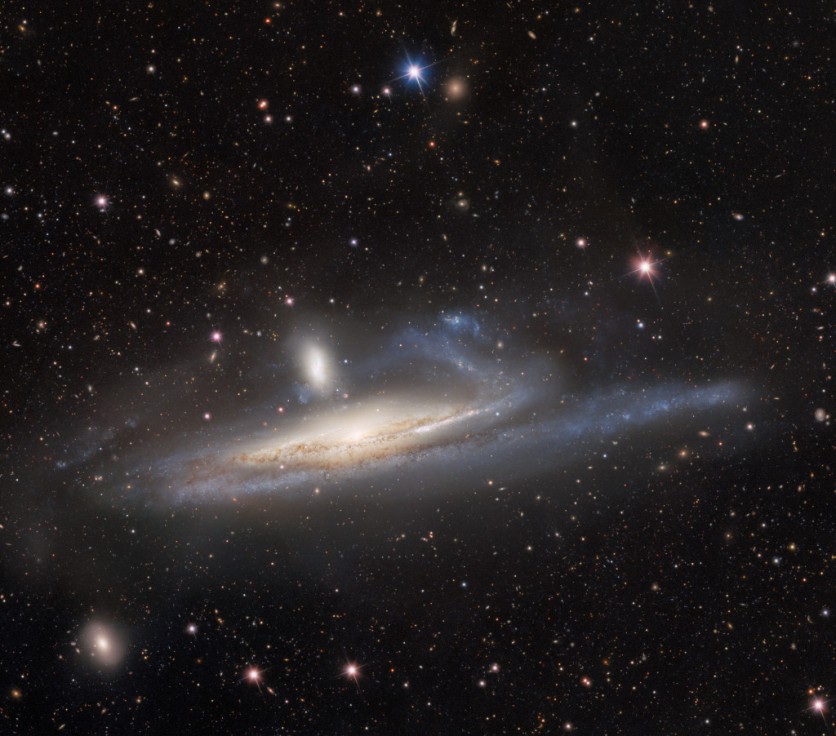Behold the cosmic spectacle where galaxies entwine in an awe-inspiring celestial tango, displaying the fascinating phenomenon known as "galactic cannibalism" —a captivating process where massive galaxies engulf smaller ones.
This captivating display is perfectly encapsulated in the featured image aptly titled "Galaxies in the River".

Galactic Cannibalism
Our gaze is drawn to the southern constellation Eridanus, known poetically as "The River," where NGC 1532 and NGC 1531 take center stage in this grand cosmic performance.
Galactic cannibalism, also known as galactic merging or galaxy interactions, is a fascinating astronomical phenomenon where large galaxies consume smaller ones that venture too close due to the influence of gravity.
In this cosmic process, massive galaxies engulf and assimilate neighboring dwarf galaxies, altering their structures and affecting their evolution.
Throughout the vast expanse of the universe, galaxies exist in various shapes and sizes, ranging from small dwarf galaxies to immense spiral and elliptical galaxies. As these galaxies roam through the cosmic void, their gravitational forces interact with neighboring galaxies, leading to gravitational attractions and orbital interactions.
NGC 1532, a breathtaking spiral galaxy stretching an astounding 100,000 light-years, is a prime example of the cosmic giants that grow by consuming neighboring smaller galaxies.
In an epic gravitational struggle, NGC 1532 envelops the dwarf galaxy NGC 1531, where the smaller participant, despite its valiant resistance, is destined to yield to the relentless embrace of gravity.
This exquisite image, captured with extraordinary precision by the Dark Energy Camera affixed to the National Science Foundation's Blanco 4-meter Telescope at the Cerro Tololo Inter-American Observatory in Chile, immortalizes this celestial dance for us to marvel at.
Dr. Richard Colombari, Dr. Mahdi Zamani, and Dr. Detlef de Martin of NSF's NOIRLab have orchestrated this breathtaking visual symphony, providing us with a front-row seat to this captivating event in the cosmos.
Read Also : NASA's Picture of the Day: Various Telescopes Stargaze at Captivating View of the Milky Way
Cosmic Hunger
The mesmerizing interaction of galactic cannibalism is not an isolated performance. Across the universe, these celestial dances unfold as large galaxies satiate their cosmic hunger by feasting on smaller ones that venture too close.
Even our own Milky Way galaxy partakes in this cosmic banquet, assimilating and incorporating smaller galaxies into its grand design.
Beyond the captivating spectacle, galactic cannibalism plays a crucial role in shaping the evolution of galaxies. As larger galaxies consume their smaller counterparts, they grow in both size and mass, evolving into the majestic structures we behold today.
The phenomenon depicted in "Galaxies in the River" finds resemblances in the well-studied M51 system, featuring a face-on spiral galaxy and its smaller companion.
These interactions offer astronomers invaluable insights into the intricate dynamics of galaxy formation and evolution, unraveling the enigmatic mysteries of the universe.
This celestial drama unfolding before our eyes is not merely an astronomical spectacle; it serves as a potent reminder of the vastness and beauty of our cosmos.
Related Article : Starry Pair: NASA's Hubble Captures Stunning Portrait of Spiral Galaxies Resembling Milky Way

ⓒ 2025 TECHTIMES.com All rights reserved. Do not reproduce without permission.




